
PREV ARTICLE
NEXT ARTICLE
FULL ISSUE
PREV FULL ISSUE
STACKS'S BOWERS MAY 2016 RARITIES SALE SELECTIONS
Below are some other lots that caught my eye in the May 25, 2016 Stack's Bowers Rarities sale. -Editor
Lot 20: 1806 Draped Bust Quarter. B-9. Rarity-1
 
1806 Draped Bust Quarter. B-9. Rarity-1. MS-64+ (PCGS). CAC. Secure Holder. Produced in limited numbers and erratically during the earliest years of U.S. Mint operations, the quarter was not a popular denomination with contemporary silver bullion depositors. Such coins were produced at the request of depositors during the late 18th and early 19th centuries, and those dealing in silver bullion much preferred half dollars and silver dollars over quarters. Even so, calendar year 1806 saw the Mint deliver an unusually large number of quarters for the era -- 206,124 pieces -- those actually bearing the date 1806 eventually requiring 10 die marriages to produce. Browning-9, offered here, vies with B-3 as the most common variety of the issue in terms of total number of coins extant. As a date, of course, the 1806 quarter is very rare in the finest Mint State grades, as indeed is the Draped Bust type as a whole. To read the complete lot description, see:
Lot 64: Proof 1894 Quarter Eagle
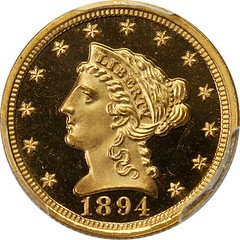 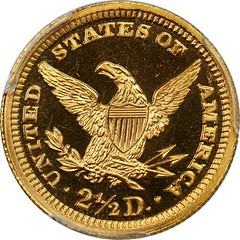
A mintage of 122 pieces for the 1894 represents a slight increase over the previous year in the total number of Proof quarter eagles struck. In keeping with the standards of this classic U.S. Mint gold series, of course, the Proof 1894 is a rare issue in an absolute sense with fewer than 100 coins believed extant in all grades. Estimates on the exact number of survivors are fairly tight between numismatic references, with Jeff Garrett and Ron Guth (2008) providing a figure of 50 to 70 coins and PCGS CoinFacts allowing for 60 to 80 pieces. A fair number of the survivors are impaired due to having been placed into circulation or otherwise mishandled by earlier generations of collectors. To read the complete lot description, see:
Lot 87 : 1807 Capped Bust Left Half Eagle
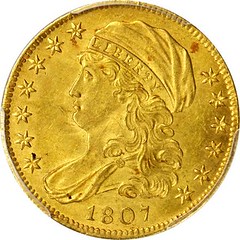 
Assistant Engraver John Reich's iconic Capped Bust Left motif made its debut in 1807. The first coins to bear the design were those that were most popular with gold and silver bullion depositors, the half eagle and half dollar. The Mint had improved its processes by this time to greatly extend working die life, so fewer varieties are known for the Capped Bust Left half eagle series as compared to its Capped Bust Right predecessor of 1795 to 1807. Indeed, numismatic scholars have identified only two die marriages for the first year 1807 Capped Bust Left, both of which employ the same obverse. To read the complete lot description, see:
Lot 145 : 1866 Pattern Liberty Quarter Eagle. Judd-542
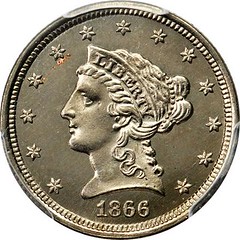 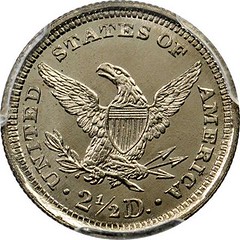
1866 Pattern Liberty Quarter Eagle. Judd-542, Pollock-607. Rarity-7+. Nickel. Reeded Edge. Proof-66 (PCGS). CAC. This is an intriguing variety and equally curious example. Despite the traditional listing of this type as a regular dies trial striking of the 1866 quarter eagle in nickel, and hence a pattern, modern numismatic scholarship entertains the possibility that Judd-542 may actually be a Mint error. Indeed, when the present example last appeared at auction in April 2015, it was certified MS-66 by NGC and attributed as being struck on a nickel three-cent planchet in error. NGC also provided the weight of this coin -- 2.04 grams -- which is in the range of tolerance for the nickel three-cent piece's authorized weight of 1.94 grams. As our current listing makes clear, PCGS differs with this assessment and has certified the coin as a pattern under the traditional Judd-542 attribution. (It is as a Judd-542 pattern certified Proof-66 by PCGS that we are offering; interested parties should factor their bids accordingly.) Regardless of its exact status as a pattern or Mint error, this is a very rare type with only four distinct specimens accounted for on the website uspatterns.com. The present example is plated on that site, and it is also the plate coin for the Judd-542 type in the 10th edition of the Judd pattern reference. Whether deliberately struck in nickel for sale to contemporary collectors or created in error, this is a highly elusive and extremely interesting piece. The rarity of Judd-542 within the pantheon of U.S. Mint patterns is beyond question, as defined above. As a Mint error this coin is rarer still, for it would be one of very few Liberty gold coins of all denominations struck on an incorrect planchet. Worthy of additional study,
A curious item. Mint records are often sparse and incomplete - no one at the time was compiling a comprehensive listing of patterns. They
were just doing their daily jobs and what we know today is based on the physical record - the coins themselves and what we can glean from
correspondence from Mint officials. Some mysteries may never be solved. -Editor
To read the complete lot description, see:
Lot 147 : Christopher Bechtler $1. K-3.
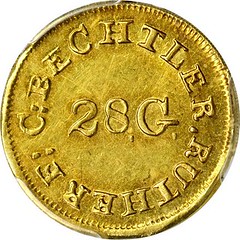 
Undated (1834-1837) Christopher Bechtler $1. K-3. Rarity-6. 28.G Centered, No Star. Reeded Edge. MS-61 (PCGS). Secure Holder. Christopher Bechtler and his son Augustus and nephew Christopher, Jr. operated their own private mint in Rutherfordton, North Carolina from 1830 to 1852. The coins were struck at two sites: at their home in Rutherfordton and near their mine just north of town. Originally housed at the American Numismatic Society Museum, the coin press and several of the dies are currently on display at the Bechtler House Museum in Rutherfordton. The family was among the earliest private minters servicing the nation's first major gold rush in the Piedmont region of North Carolina and Georgia. Kagin-3, offered here, is one of Christopher Bechtler, Sr.'s rarer gold dollars and is seen far less often than the popular N Reversed variety (K-4). Provenance: Ex Eric P. Newman Numismatic Education Society; Heritage's sale of the Eric P. Newman Collection, Part V, November 2014, lot 3458. To read the complete lot description, see:
Lot 148 : 1850 Baldwin & Co. $5 Gold
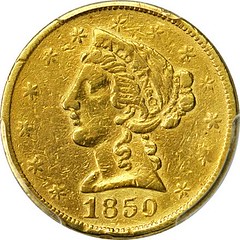 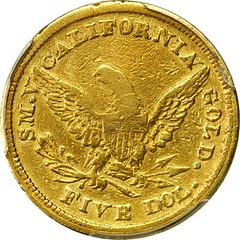
San Francisco-based jewelers George C. Baldwin and Thomas S. Holman operated as Baldwin & Co. during the California Gold Rush. They expanded into assaying and coining in 1850 when they acquired machinery and other equipment from F.D. Kohler, who had been appointed California State Assayer by Governor Peter Burnett on April 12 of that year. While the most famous and eagerly sought Baldwin & Co. coins are the 1850 Horseman type $10, the firm's coinage features other notably scarce and rare pieces, including the legendary 1851 $20 with only four to six examples known.
Private gold coins are a fascinating and important component of U.S. financial and numismatic history. This well-worn example brought
$885 in an October 1964 French's sale, a large sum for the time. -Editor
To read the complete lot description, see:
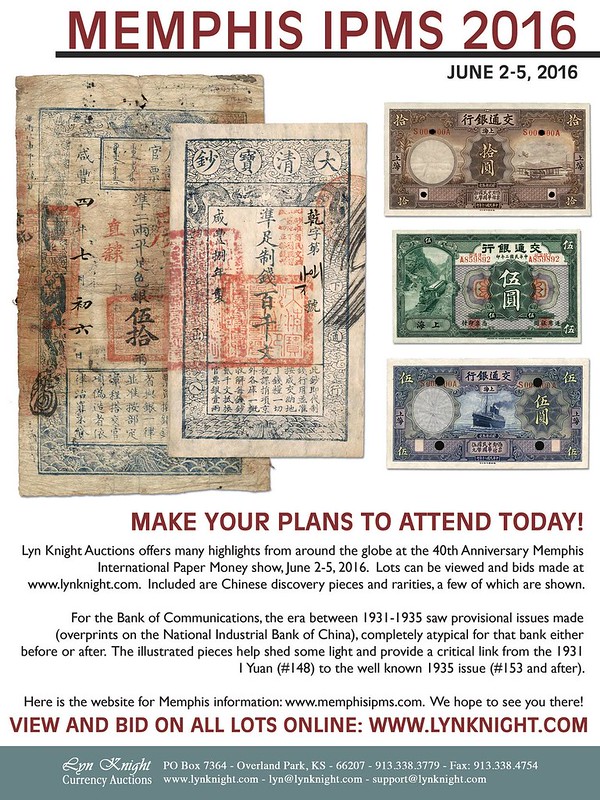
Wayne Homren, Editor The Numismatic Bibliomania Society is a non-profit organization promoting numismatic literature. See our web site at coinbooks.org. To submit items for publication in The E-Sylum, write to the Editor at this address: whomren@gmail.com To subscribe go to: https://my.binhost.com/lists/listinfo/esylum All Rights Reserved. NBS Home Page Contact the NBS webmaster 
|